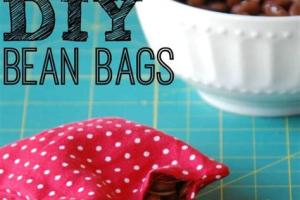Ultimate Guide to DIY Bean Bags: Create Fun Party Games and Comfortable Seating

-
Quick Links:
- Introduction
- Materials Needed
- Design Ideas for DIY Bean Bags
- Step-by-Step Guide to Making Bean Bags
- Choosing the Right Filling
- Decorating Your Bean Bags
- Safety Tips
- Case Studies: Successful DIY Projects
- Expert Insights on Bean Bag Materials
- FAQs
Introduction
Bean bags have become a beloved staple in both casual and formal settings, providing comfort and a touch of fun. From party games to additional seating, DIY bean bags can be tailored to fit your specific needs. In this guide, we will explore how to create your own bean bags, offering step-by-step instructions, design ideas, and tips on materials and fillings.
Materials Needed
Creating your own bean bags requires a few essential materials. Here’s a comprehensive list:
- Fabric: Choose durable, machine-washable fabric like cotton or canvas.
- Filling: Options include polystyrene beads, shredded foam, or natural materials like dried beans.
- Sewing Supplies: Thread, scissors, sewing machine, and pins.
- Measuring Tape: For accurate dimensions.
- Marker/Pencil: For marking fabric.
Design Ideas for DIY Bean Bags
When it comes to design, the possibilities are endless. Here are some ideas:
- Classic Round Shape: Timeless and easy to make.
- Square Bean Bags: Great for stacking and versatile use.
- Custom Shapes: Create bean bags in unique forms like animals or characters for kids’ parties.
- Color and Pattern: Use colorful fabrics or patterns to match your party theme.
Step-by-Step Guide to Making Bean Bags
Follow this detailed guide to create your DIY bean bags:
Step 1: Measure and Cut Fabric
Decide on the size of your bean bag. For a standard size, cut two pieces of fabric measuring 30 inches by 30 inches.
Step 2: Sew the Fabric
Place the fabric pieces right sides together and sew around the edges, leaving a small opening for filling. Use a straight stitch with a 1/2 inch seam allowance.
Step 3: Turn Inside Out
Once sewn, turn the bean bag inside out through the opening.
Step 4: Fill the Bean Bag
Carefully fill the bean bag with your chosen filling until it reaches your desired firmness.
Step 5: Close the Opening
Fold the edges of the opening inward and sew it closed using a slip stitch or machine sewing.
Choosing the Right Filling
Choosing the right filling is crucial for comfort and durability. Here are some popular options:
- Polystyrene Beads: Lightweight and provide good support.
- Shredded Foam: Offers a plush feel and conforms to the body.
- Natural Materials: Consider dried beans or rice for eco-friendly options.
Decorating Your Bean Bags
Add a personal touch to your bean bags with these decoration ideas:
- Fabric Paint: Create unique designs or messages.
- Iron-On Transfers: Apply fun graphics and patterns.
- Patchwork: Combine different fabric pieces for a creative look.
Safety Tips
Keep safety in mind while making and using your bean bags:
- Ensure all seams are securely sewn to prevent filling from escaping.
- Keep small beans or beads out of reach of young children.
- Use non-toxic materials for decoration.
Case Studies: Successful DIY Projects
Many DIY enthusiasts have successfully created bean bags for various occasions. Here’s a couple of inspiring examples:
Case Study 1: Backyard Movie Night
A family hosted a backyard movie night and created colorful bean bags for seating. They used outdoor fabric, ensuring durability against the elements.
Case Study 2: Kids’ Birthday Party
A parent made themed bean bags shaped like cartoon characters for their child’s birthday party, which became a hit among guests.
Expert Insights on Bean Bag Materials
According to fabric experts, choosing the right materials can significantly affect the longevity and comfort of your bean bags. Look for fabrics that are both sturdy and easy to clean. Additionally, consider the environmental impact of your filling choice, opting for sustainable materials when possible.
FAQs
Here are some common questions and answers regarding DIY bean bags:
- Q: How long do DIY bean bags last? A: With proper care, DIY bean bags can last several years.
- Q: Can I wash my bean bags? A: Yes, if made from machine-washable fabric, you can wash them, but check the filling material as well.
- Q: What size should I make my bean bags? A: It depends on your intended use, but a 30x30 inch size is versatile.
- Q: Are DIY bean bags safe for children? A: Yes, as long as they are made securely and monitored for small filling materials.
- Q: Can I use scrap fabric for bean bags? A: Absolutely! Scrap fabric can make unique and colorful bean bags.
- Q: How do I prevent my bean bags from losing shape? A: Use quality filling and consider adding a liner for extra support.
- Q: What types of fillings are best for indoor vs outdoor use? A: Indoor options like polystyrene beads are great, while outdoor bean bags should use water-resistant fillings.
- Q: How do I repair a torn bean bag? A: Sew the tear with needle and thread, or patch it with fabric adhesive.
- Q: What is the best way to store bean bags when not in use? A: Store them in a dry, cool place to prevent mold and mildew.
- Q: How do I choose a theme for my bean bag designs? A: Consider the occasion or the interests of your target audience for theme inspiration.
Now that you have all the information needed to create your DIY bean bags, gather your materials and get started. Enjoy the process of crafting something unique for your next party or event!